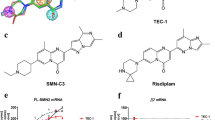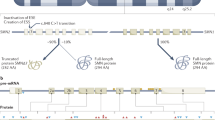Abstract
Proximal spinal muscular atrophy (SMA) is an autosomal recessive neuromuscular disorder caused by mutations of the SMN1 gene. Based on severity, three forms of SMA are recognized (types I–III). All patients usually have 2–4 copies of a highly homologous gene (SMN2), which produces insufficient levels of functional survival motor neuron (SMN) protein due to the alternative splicing of exon 7. The availability of potential candidates to the treatment of SMA has raised a number of issues, including the availability of biomarkers. This study was aimed at evaluating whether the quantification of SMN2 products in peripheral blood is a suitable biomarker for SMA. Forty-five adult type III patients were evaluated by Manual Muscle Testing, North Star Ambulatory Assessment scale, 6-min walk test, myometry, forced vital capacity, and dual X-ray absorptiometry. Molecular assessments included SMN2 copy number, levels of full-length SMN2 (SMN2-fl) transcripts and those lacking exon 7 and SMN protein. Clinical outcome measures strongly correlated to each other. Lean body mass correlated inversely with years from diagnosis and with several aspects of motor performance. SMN2 copy number and SMN protein levels were not associated with motor performance or transcript levels. SMN2-fl levels correlated with motor performance in ambulant patients. Our results indicate that SMN2-fl levels correlate with motor performance only in patients preserving higher levels of motor function, whereas motor performance was strongly influenced by disease duration and lean body mass. If not taken into account, the confounding effect of disease duration may impair the identification of potential SMA biomarkers.
Similar content being viewed by others
Log in or create a free account to read this content
Gain free access to this article, as well as selected content from this journal and more on nature.com
or
References
Pearn J : Classification of spinal muscular atrophies. Lancet 1980; 1: 919–922.
Munsat TL, Davies KE : International SMA consortium meeting (26–28 June 1992, Bonn, Germany). Neuromuscul Disord 1992; 2: 423–428.
Zerres K, Rudnik-Schöneborn S, Forrest E et al: A collaborative study on the natural history of childhood and juvenile onset proximal spinal muscular atrophy (type II and III SMA): 569 patients. J Neurol Sci 1997; 146: 67–72.
Lefebvre S, Bürglen L, Reboullet S et al: Identification and characterization of a spinal muscular atrophy-determining gene. Cell 1995; 80: 155–165.
Wirth B : An update of the mutation spectrum of the survival motor neuron gene (SMN1) in autosomal recessive spinal muscular atrophy (SMA). Hum Mut 2000; 15: 228–237.
Frugier T, Tiziano FD, Cifuentes-Diaz C et al: Nuclear targeting defect of SMN lacking the C-terminus in a mouse model of spinal muscular atrophy. Hum Mol Genet 2000; 9: 849–858.
Lefebvre S, Burlet P, Liu Q et al: Correlation between severity and SMN protein level in spinal muscular atrophy. Nat Genet 1997; 16: 265–269.
Coovert DD, Le TT, McAndrew PE et al: The survival motor neuron protein in spinal muscular atrophy. Hum Mol Genet 1997; 6: 1205–1214.
Patrizi AL, Tiziano F, Zappata S et al: SMN protein analysis in fibroblast, amniocyte, and CVS cultures from spinal muscular atrophy patients and its relevance for diagnosis. Eur J Hum Genet 1999; 7: 301–309.
Feldkötter M, Schwarzer V, Wirth R et al: Quantitative analysis of SMN1 and SMN2 based on real-time LightCycler PCR: fast and highly reliable carrier testing and prediction of severity of spinal muscular atrophy. Am J Hum Genet 2002; 70: 358–368.
Tiziano FD, Bertini E, Messina S et al: The Hammersmith functional score correlates with the SMN2 copy number: a multicentric study. Neuromuscul Disord 2007; 17: 400–403.
Wirth B, Brichta L, Schrank B et al: Mildly affected patients with spinal muscular atrophy are partially protected by an increased SMN2 copy number. Hum Genet 2006; 119: 422–428.
Brichta L, Hofmann Y, Hahnen E et al: Valproic acid increases the SMN2 protein level: a well-known drug as a potential therapy for spinal muscular atrophy. Hum Mol Genet 2003; 12: 2481–2489.
Andreassi C, Angelozzi C, Tiziano FD et al: Phenylbutyrate increases SMN expression in vitro: relevance for treatment of spinal muscular atrophy. Eur J Hum Genet 2004; 12: 59–65.
Brahe C, Vitali T, Tiziano FD et al: Phenylbutyrate increases SMN gene expression in spinal muscular atrophy patients. Eur J Hum Genet 2005; 13: 256–259.
Jarecki J, Chen X, Bernardino A et al: Diverse small-molecule modulators of SMN expression found by high-throughput compound screening: early leads towards a therapeutic for spinal muscular atrophy. Hum Mol Genet 2005; 14: 2003–2018.
Angelozzi C, Borgo F, Tiziano FD et al: Salbutamol increases SMN mRNA and protein levels in spinal muscular atrophy cells. J Med Genet 2008; 45: 29–31.
Pane M, Staccioli S, Messina S et al: Daily salbutamol in young patients with SMA type II. Neuromuscul Disord 2008; 18: 536–540.
Mercuri E, Bertini E, Messina S et al: Randomized, double-blind, placebo-controlled trial of phenylbutyrate in spinal muscular atrophy. Neurology 2007; 68: 51–55.
Tiziano FD, Lomastro R, Pinto AM et al: Salbutamol increases SMN transcript levels in leukocytes of spinal muscular atrophy patients: relevance for clinical trial design. J Med Genet 2010; 47: 856–858.
Hua Y, Sahashi K, Hung G et al: Antisense correction of SMN2 splicing in the CNS rescues necrosis in a type III SMA mouse model. Genes Dev 2010; 24: 1634–1644.
Singh NN, Shishimorova M, Cao LC et al: A short antisense oligonucleotide masking a unique intronic motif prevents skipping of a critical exon in spinal muscular atrophy. RNA Biol 2009; 6: 341–350.
Kaufmann P, Muntoni F : Issues in SMA clinical trial design. The International Coordinating Committee (ICC) for SMA Subcommittee on SMA Clinical Trial Design. Neuromuscul Disord 2007; 17: 499–505.
Florence JM, Pandya S, King WM et al: Intrarater reliability of manual muscle test (Medical Research Council scale) grades in Duchenne’s muscular dystrophy. Phys Ther 1992; 72: 115–122.
Merlini L, Mazzone ES, Solari A et al: Reliability of hand-held dynamometry in spinal muscular atrophy. Muscle Nerve 2002; 26: 64–70.
Mercuri E, Mayhew A, Muntoni F et al: Towards harmonisation of outcome measures for DMD and SMA within TREAT-NMD; Report of three expert workshops: TREAT-NMD/ENMC workshop on outcome measures, 12th–13th May 2007, Naarden, The Netherlands; TREAT-NMD workshop on outcome measures in experimental trials for DMD, 30th June–1st July 2007, Naarden, The Netherlands; Conjoint Institute of Myology TREAT-NMD Meeting on physical activity monitoring in neuromuscular disorders, 11th July 2007, Paris, France. Neuromuscul Disord 2008; 18: 894–903.
Takeuchi Y, Katsuno M, Banno H et al: Walking capacity evaluated by the 6-minute walk test in spinal and bulbar muscular atrophy. Muscle Nerve 2008; 38: 964–971.
Montes J, McDermott MP, Martens WB et al. Muscle Study Group and the Pediatric Neuromuscular Clinical Research Network: Six-Minute Walk Test demonstrates motor fatigue in spinal muscular atrophy. Neurology 2010; 74: 833–838.
Khatri IA, Chaudhry US, Seikaly MG et al: Low bone mineral density in spinal muscular atrophy. J Clin Neuromuscul Dis 2008; 10: 11–17.
Kinali M, Banks LM, Mercuri E et al: Bone mineral density in a paediatric spinal muscular atrophy population. Neuropediatrics 2004; 35: 325–328.
van der Steege G, Grootscholten PM, van der Vlies P et al: PCR-based DNA test to confirm clinical diagnosis of autosomal recessive spinal muscular atrophy. Lancet 1995; 345: 985–986.
Prior TW, Krainer AR, Hua Y et al: A positive modifier of spinal muscular atrophy in the SMN2 gene. Am J Hum Genet 2009; 85: 408–413.
Tiziano FD, Pinto AM, Fiori S et al: SMN transcript levels in leukocytes of SMA patients determined by absolute real time PCR. Eur J Hum Genet 2010; 18: 52–58.
Sossi V, Giuli A, Vitali T et al: Premature termination mutations in exon 3 of the SMN1 gene are associated with exon skipping and a relatively mild SMA phenotype. Eur J Hum Genet 2001; 9: 113–120.
Hahnen E, Schonling J, Raschke H et al: Missense mutations in exon 6 of the survival motor neuron gene in patients with spinal muscular atrophy. Hum Mol Genet 1997; 6: 821–825.
Sproule DM, Kaufmann P : Therapeutic developments in spinal muscular atrophy. Ther Adv Neurol Disord 2010; 3: 173–185.
Glanzman AM, O'Hagen JM, McDermott MP et al. Pediatric Neuromuscular Clinical Research Network for Spinal Muscular Atrophy (PNCR); Muscle Study Group (MSG): Validation of the Expanded Hammersmith Functional Motor Scale in Spinal Muscular Atrophy Type II and III. J Child Neurol 2011; 26: 1499–1507.
Vezain M, Saugier-Veber P, Goina E et al: A rare SMN2 variant in a previously unrecognized composite splicing regulatory element induces exon 7 inclusion and reduces the clinical severity of spinal muscular atrophy. Hum Mutat 2010; 31: E1110–E1125.
Finkel RS, Crawford TO, Swoboda KJ et al. Pilot Study of Biomarkers for Spinal Muscular Atrophy Trial Group: Candidate proteins, metabolites and transcripts in the Biomarkers for Spinal Muscular Atrophy (BforSMA) clinical study. PLoS One 2012; 7: e35462.
Crawford TO, Paushkin SV, Kobayashi DT et al Pilot Study of Biomarkers for Spinal Muscular Atrophy Trial Group: Evaluation of SMN protein, transcript, and copy number in the biomarkers for spinal muscular atrophy (BforSMA) clinical study. PLoS One 2012; 7: e33572.
Acknowledgements
The present study is dedicated to the memory of Christina Brahe. We are grateful to the SMA Foundation for kindly providing SMN ELISA kits, and to Dr Dione Kobayashi, Professor Eugenio Mercuri, and Dr Enrico Bertini for critical comments on the manuscript. We are extremely grateful to the patients and their families. The study was funded by the Agenzia Italiana del Farmaco (AIFA). Carla Angelozzi has been granted by ASAMSI.
Disclaimer
FDT and LM had full access to all study data and take responsibility for the integrity of the data and the accuracy of the analyses.
Author information
Authors and Affiliations
Corresponding author
Ethics declarations
Competing interests
The authors declare no conflict of interest.
Additional information
Supplementary Information accompanies the paper on European Journal of Human Genetics website
Supplementary information
Rights and permissions
About this article
Cite this article
Tiziano, F., Lomastro, R., Di Pietro, L. et al. Clinical and molecular cross-sectional study of a cohort of adult type III spinal muscular atrophy patients: clues from a biomarker study. Eur J Hum Genet 21, 630–636 (2013). https://doi.org/10.1038/ejhg.2012.233
Received:
Revised:
Accepted:
Published:
Issue date:
DOI: https://doi.org/10.1038/ejhg.2012.233
Keywords
This article is cited by
-
Transcript, methylation and molecular docking analyses of the effects of HDAC inhibitors, SAHA and Dacinostat, on SMN2 expression in fibroblasts of SMA patients
Journal of Human Genetics (2016)
-
Decay in survival motor neuron and plastin 3 levels during differentiation of iPSC-derived human motor neurons
Scientific Reports (2015)



